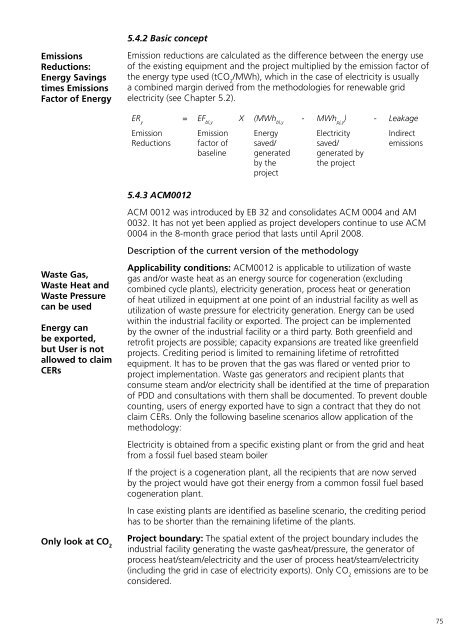Understanding CDM Methodologies - SuSanA
Understanding CDM Methodologies - SuSanA
Understanding CDM Methodologies - SuSanA
You also want an ePaper? Increase the reach of your titles
YUMPU automatically turns print PDFs into web optimized ePapers that Google loves.
5.4.2 Basic concept<br />
Emissions<br />
Reductions:<br />
Energy Savings<br />
times Emissions<br />
Factor of Energy<br />
Emission reductions are calculated as the difference between the energy use<br />
of the existing equipment and the project multiplied by the emission factor of<br />
the energy type used (tCO 2<br />
/MWh), which in the case of electricity is usually<br />
a combined margin derived from the methodologies for renewable grid<br />
electricity (see Chapter 5.2).<br />
ER y<br />
= EF bl,y<br />
X (MWh bl,y<br />
- MWh pj,y<br />
) - Leakage<br />
Emission<br />
Reductions<br />
5.4.3 ACM0012<br />
Emission<br />
factor of<br />
baseline<br />
Energy<br />
saved/<br />
generated<br />
by the<br />
project<br />
Electricity<br />
saved/<br />
generated by<br />
the project<br />
Indirect<br />
emissions<br />
ACM 0012 was introduced by EB 32 and consolidates ACM 0004 and AM<br />
0032. It has not yet been applied as project developers continue to use ACM<br />
0004 in the 8-month grace period that lasts until April 2008.<br />
Description of the current version of the methodology<br />
Waste Gas,<br />
Waste Heat and<br />
Waste Pressure<br />
can be used<br />
Energy can<br />
be exported,<br />
but User is not<br />
allowed to claim<br />
CERs<br />
Only look at CO 2<br />
Applicability conditions: ACM0012 is applicable to utilization of waste<br />
gas and/or waste heat as an energy source for cogeneration (excluding<br />
combined cycle plants), electricity generation, process heat or generation<br />
of heat utilized in equipment at one point of an industrial facility as well as<br />
utilization of waste pressure for electricity generation. Energy can be used<br />
within the industrial facility or exported. The project can be implemented<br />
by the owner of the industrial facility or a third party. Both greenfield and<br />
retrofit projects are possible; capacity expansions are treated like greenfield<br />
projects. Crediting period is limited to remaining lifetime of retrofitted<br />
equipment. It has to be proven that the gas was flared or vented prior to<br />
project implementation. Waste gas generators and recipient plants that<br />
consume steam and/or electricity shall be identified at the time of preparation<br />
of PDD and consultations with them shall be documented. To prevent double<br />
counting, users of energy exported have to sign a contract that they do not<br />
claim CERs. Only the following baseline scenarios allow application of the<br />
methodology:<br />
Electricity is obtained from a specific existing plant or from the grid and heat<br />
from a fossil fuel based steam boiler<br />
If the project is a cogeneration plant, all the recipients that are now served<br />
by the project would have got their energy from a common fossil fuel based<br />
cogeneration plant.<br />
In case existing plants are identified as baseline scenario, the crediting period<br />
has to be shorter than the remaining lifetime of the plants.<br />
Project boundary: The spatial extent of the project boundary includes the<br />
industrial facility generating the waste gas/heat/pressure, the generator of<br />
process heat/steam/electricity and the user of process heat/steam/electricity<br />
(including the grid in case of electricity exports). Only CO 2<br />
emissions are to be<br />
considered.<br />
75

















